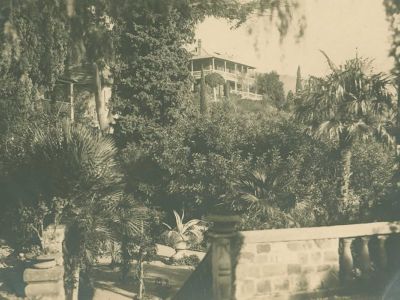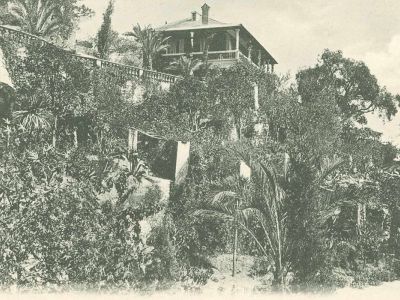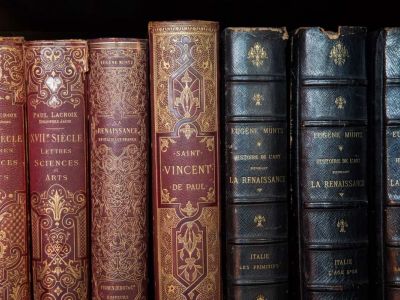The History
of Villa della Pergola
Villa della Pergola makes its entry into the Italian Historic Houses.
Casa Nirvana is inaugurated, a new area of Villa della Pergola where there is a SPA, Wellness area and an Infinity Pool overlooking the sea.
The Gardens of Villa della Pergola are awarded as the "most beautiful park in Italy".
The Nove Restaurant obtains its first Michelin star.
Villa della Pergola enters the Relais& Châteaux.family
The Nove restaurant opens its doors.
after years of meticulous restoration the work is finally finished. The Gardens are so returned to the community to be enjoyed by all enthusiasts and the Villa reopens its doors, becoming a charming relais.
The restoration and recovery works of the Park and the Villas begin. A precious help is arrived by the architect Ettore Mocchetti, who occupied with the interiors of the Villas, rooms and suites, while to carry out the recovery and valorisation project of the Park, the famous landscape architect Paolo Pejrone, probably one of the most important in the world, immediately accepted the challenge with enthusiasm.
Villa della Pergola and its gardens were purchased at a judicial auction and thus saved. from a building speculation that would have canceled and transformed this part of the hill forever and with it a part of history and a symbol of Alassio and the entire Riviera di Ponente.
The Villino in the sixties and seventies was used as an outbuilding of the nearby Villa by the writer and painter Carlo Levi who immortalized the landscape of Alassio in countless canvases, hosting his friend Italo Calvino right here every year, to whom he used to give an always different portrait.
Oscar winner Guy Green set his film The Snorkel here in 1957, with Betta St. John, Peter Van Eyck and Mandy Miller.
Daniel dies suddenly and Ruth returns to live in Villa della Pergola, gathering around her a small and sparse colony of Anglo-Alassini. His wisteria parties in spring, during the flowering of the wisteria, were famous, at which, among others, the writer Cecil Roberts was often guests, who dedicated in Alassio the book Portal to Paradise and the Bishop of Gibraltar, who every spring visited the communities Anglican in the Riviera staying here as a guestdi Ruth.
At the outbreak of war, the Hanbury family, like most of the English on the Riviera, returned to England.
Alfred Hitchcock shot some scenes of his first feature film The Pleasure Garden here.
The residence was purchased by Daniel Hanbury, second son of Sir Thomas Hanbury of the Mortola, convinced to purchase the property. right after reading William Scott's words.
William Scott in his historical-artistic guide entitled The Riviera describes this place: "A worthy rival of Thomas Hanbury's Giardini della Mortola can be found here. find in the magnificent property of Villa della Pergola, belonging to Sir Walter Hamilton-Dalrymple, here a genuine love for nature, an intimate knowledge of the art of gardening and a perfect taste in design, combined with a careful and generous budget, have produced one of the wonders of the Riviera".
The English composer Edward Elgar composed the symphony In the South (Alassio), which will be released directed by the m° Riccardo Muti at the Teatro alla Scala in honor of Queen Elizabeth II in 2000 on the occasion of her visit to Italy.
the property it was sold by the widow Lady McMurdo and the general's children to Sir Walter Hamilton-Dalrymple, a Scottish baronet descended from an ancient and noble loyalist family of North Berwick, Scotland, related among others to the writer Virginia Woolf.
Construction of the Park begins.
The McMurdo family began work on the second building, the one that would later give this place its name: Villa della Pergola.
ilGeneral McMurdo purchases two large pieces of land - the Parco Fuor del Vento and the Molino di Sopra - on the hill of Alassio, in the locality It costs. Construction begins on the Villino della Pergola called "Casa Napier".
The story you are about to read today might no longer exist, if the Villas and Gardens had not been saved in 2006 by building speculation that would have erased forever this historical heritage and priceless beauty, which represents, indelible, the history, the splendor and the culture of this part of Italy, defined in the nineteenth century as the "Italian Riviera".
Inextricably intertwined with the birth of the English winter holiday in Alassio, Villa della Pergola, thanks to the important recovery following a refined work of historical and philological research, has returned to preserve the unmistakable atmospheres of that period.
Rescue and recovery
The new history of Villa della Pergola begins in 2006, when it emerged from local newspapers that the entire property would be put up for auction: the interest was not in maintaining, recovering, enhancing, but in creating new residential units inside the Park. A building speculation to transform the hill.
To avoid this sad eventuality, which would have erased the entire hill and with it an important part of the history of the Ligurian Riviera and Alassio, Villa della Pergola and its Gardens were purchased by Silvia and Antonio Ricci.
The situation was critical: it was necessary to understand what was underneath that blanket of abandonment. The Villas were in need of a major restoration and the Park, only reminiscent of the glories of the past that were talked about, from afar appeared like a large green spot.
A thorough cleaning of all 22 thousand square meters of the Garden then began. The works lasted six months and there were no shortage of worrying and discouraging surprises. But right at that moment we started to imagine and dream of what this place could have become.
And so began the long restoration work of the Garden and the Villas, starting right from Villa della Pergola, having as a guide only faded period photographs recovered who knows where, among archives, donations and good will of friends and old Alassians who supported this challenge. Valuable help came from the architect Ettore Mocchetti, who took care of the interiors of the Villas, rooms and suites, while to carry out the project of recovery and valorisation of the Park, the famous landscape architect Paolo Pejrone, probably one of the most important in the world, immediately accepted the challenge with enthusiasm. The works ended in 2012. After years of meticulous restoration and great sacrifices, the Gardens were returned to the community to be enjoyed by all enthusiasts and the Villa reopened its doors, becoming a charming relais today part of the exclusive Relais & Châteaux family.
The English families in the history of Villa della Pergola
The Mc Murdos
The history of Villa della Pergola begins in 1875, when two Scottish gentlemen, George Henderson Gibb and General William Montagu Scott McMurdo, were the first Britons, together with their families, to spend an entire winter in Alassio. The following year they decided to purchase two large pieces of land, Parco Fuor del Vento and Molino di Sopra, on the Alassio hill, in the Costa area.
The history of Villa della Pergola begins in 1875, when two Scottish gentlemen, George Henderson Gibb and General William Montagu Scott McMurdo, were the first Britons, together with their families, to spend an entire winter in Alassio. The following year they decided to purchase two large pieces of land, Parco Fuor del Vento and Molino di Sopra, on the Alassio hill, in the Costa area. On a pre-existing residence of the Counts of Lengueglia, General McMurdo immediately built the Villino della Pergola calling it "Casa Napier" in honor of his father-in-law, General Sir Charles Napier, celebrated English leader and hero, whose fame and prestige honored him with a statue in London in Trafalgar Square, right in front of the National Gallery.
The Villino was designed and built according to Anglo-Indian colonial canons and taste, developed on three levels and equipped with a large loggia, exactly as was customary for the homes of officials of the British Empire. This architectural style was loved by the English who had lived most of their lives in the colonies in India and Malaya as military men, civil officials or businessmen.
In 1880 the McMurdo family began work on the second building, the one that would later give this place its name: Villa della Pergola.
The Villa, the first of many that will be built on the Alassio hills in a few years, was built in a slightly lower position than the Villino, but larger in size and following an eclectic taste. The large loggia returns, but at the same time with elements of greater value and splendor such as the dome covered in rare polychrome majolica from Albisola, the flood of marble and the spectacular fountain near the staircase.
The design of the Park was also the work of the McMurdo family, conceived as a natural continuation of the internal environments of the villas towards the sun and flora of the Mediterranean. It was then developed on several terraced levels, following the natural course of the hill and making room, among olive and orange groves, for Canarian palms, Washingtonias, Dactiliferes and, naturally, for cypresses, a tribute to the love for the landscape and for the avenues Tuscans of the Anglo-Florentine colony.
The Dalrymples
General McMurdo died in Nice in 1894, and in 1900, the property was sold by his widow Lady McMurdo and the General's children to Sir Walter Hamilton-Dalrymple, a Scottish baronet descended from an ancient and noble Loyalist family of North Berwick, in Scotland, related among others to the writer Virginia Woolf.
Sir Walter, passing through the Riviera, was struck by the beauty of the bay of Alassio, in particular by the suggestive profile of Gallinara Island. From the first glance he glimpsed the surprising resemblance between the unmistakable shape of a turtle emerging from the sea of this island with Bass Rock Island, a Scottish island he owns just off the coast of North Berwick.
Sir Walter took care of the park by innovating the entire tree system and eliminating every barrier that had previously divided Villa della Pergola from the Villino, having three small wooden bridges built to connect them, bridges that still today allow you to climb over the mule track that climbs up the side of the hill. Thanks to him, the interior of the Villa was also embellished, with the white Carrara marble staircase. He was also responsible for the construction of Casa del Sole, a pavilion used during the summer by him and his guests to spend most of the hours of the day.
Precisely thanks to these changes, in 1907, William Scott in his historical-artistic guide entitled The Riviera describes this place: "A worthy rival of Thomas Hanbury's Mortola Gardens can be found in the magnificent property of Villa della Pergola, belonging to Sir Walter Hamilton-Dalrymple, here a genuine love of nature, an intimate knowledge of the art of gardening and perfect taste in planning, combined with a careful and generous budget, have produced one of the wonders of the Riviera".
The Dalrymples held the property for around twenty years until, in 1922, Sir Hew Clifford Hamilton-Dalrymple, ninth baronet, sold the house to Daniel Hanbury, second son of Sir Thomas Hanbury della Mortola, who convinced his son to purchase the property right after reading William Scott's words.
The Hanburys
Thomas Hanbury, a businessman and former owner of the Mortola gardens in Ventimiglia, had anticipated the potential of Alassio as a winter health resort, foreseeing the same success as Mentone, Bordighera and Sanremo. For this reason, upon his death in 1907, he left the management of the real estate activities undertaken in Alassio to his son Daniel.
The Hanbury family, especially thanks to Daniel's wife, Sylvia, gave an extraordinary impetus to the development of the Villa's garden, transporting varieties of South American cacti, collections of Australian cycads and eucalyptus and other various types of essences from the Mortola botanical garden, increasing significantly the variety of exotic species in the Park. In 1940, at the outbreak of war, the Hanbury family, like most English people on the Riviera, returned to England. Daniel, widowed, married Ruth Hardinge for the second time, also coming from a family from the English colony of Alassio.
In 1946 the Hanburys returned to Alassio to resume work interrupted by the war, but in 1948, Daniel died suddenly and with him the main architect of the town's success as an elite winter health resort passed away.
Ruth returns to live in Villa della Pergola, gathering around her a small and sparse colony of Anglo-Alassini, now a shadow of the over three thousand pre-war English residents. His Wisteria parties in spring during the flowering of the wisteria remain famous. Among its illustrious guests were the Bishop of Gibraltar, who every year visited the Anglican communities on the Riviera, staying here as Ruth's guest, and the writer Cecil Roberts, who in 1955 dedicated the book Portal to Paradise to Alassio in which he defined her "Pearl of the Ligurian Riviera".
Subsequently the Villa experienced a period of abandonment and its history was rewritten thanks to the rescue in 2006.
The museum
The immersion in the history of this place continues in the small museum.
Rarities and unique pieces, memorabilia, images, portraits and paintings from Alassio and nineteenth-century Liguria tell the story of the Villa, the aristocratic English families and the characters from all over the world who stayed and wrote the script of its history. The paintings on the walls that accompany guests in the various rooms form the most important existing collection of paintings having Western Liguria as their subject.
A widespread museum, which from the heart of Villa della Pergola continues inside the Villas and rooms, where relics and original objects evoke the spirit of the era.
The illustrious guests of Villa della Pergola
Villa della Pergola has always been a place full of history and inspiration. Artists and directors such as Alfred Hitchcock, who in 1925 shot some scenes of his first film The Pleasure Garden on the beach of Alassio and in the park of the Villa, and Guy Green, Oscar winner, who in 1957 set his film The Snorkel, with Betta St. John, Peter Van Eyck and Mandy Miller.
In the sixties and seventies, the Villino was used as an annex to the Villa that the writer and painter Carlo Levi owned nearby. Levi immortalized the landscape of Alassio in countless canvases and hosted his dear friend Italo Calvino right here, to whom he painted and gave a portrait every year.
Still today this place is the favorite destination of personalities from all over the world, guests sensitive to the philosophy that distinguishes Villa della Pergola and who make it their favorite refuge. People looking for an oasis of peace and tranquility, privacy and a unique experience: staying in a historical heritage immersed in a botanical park.









